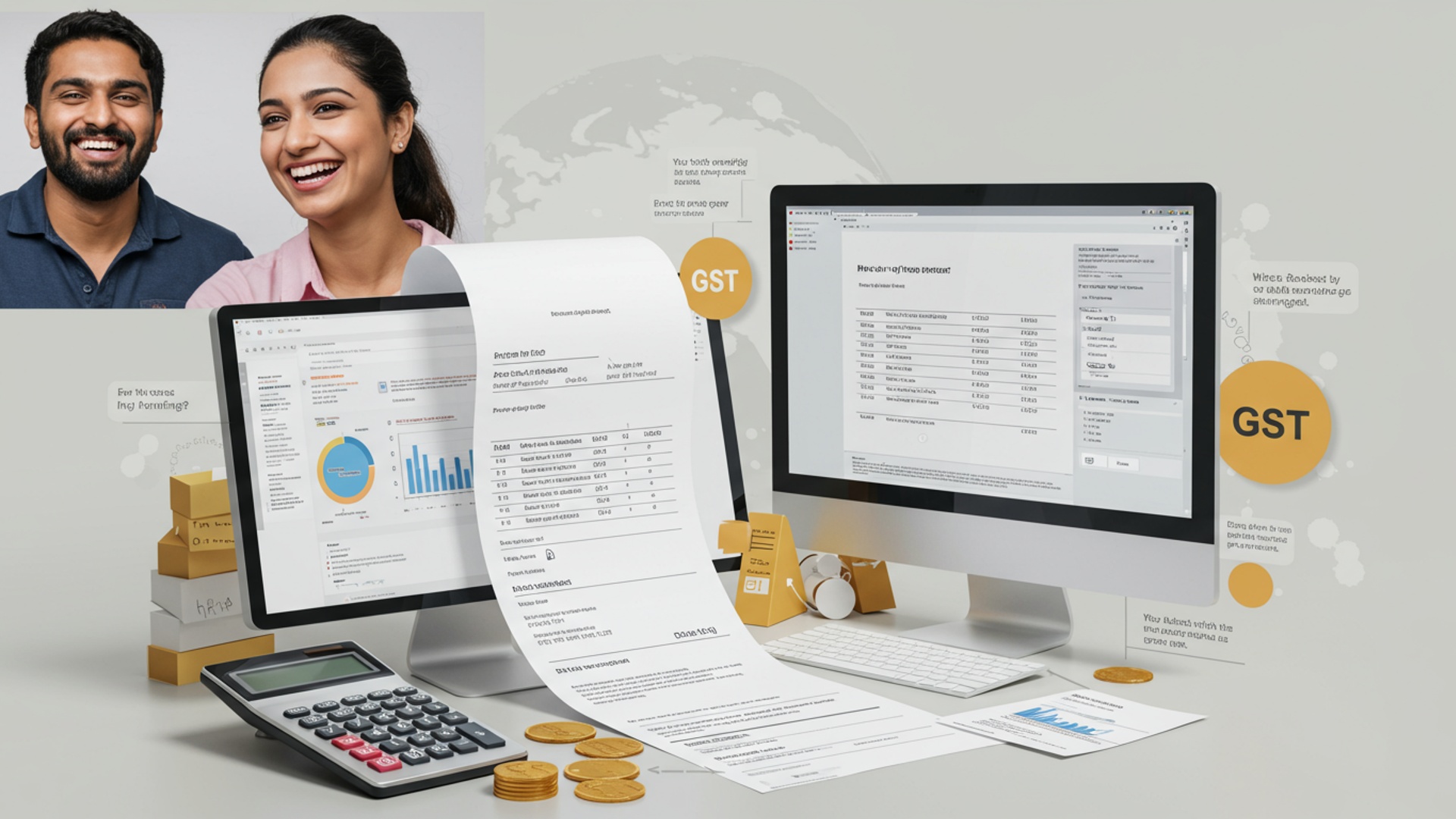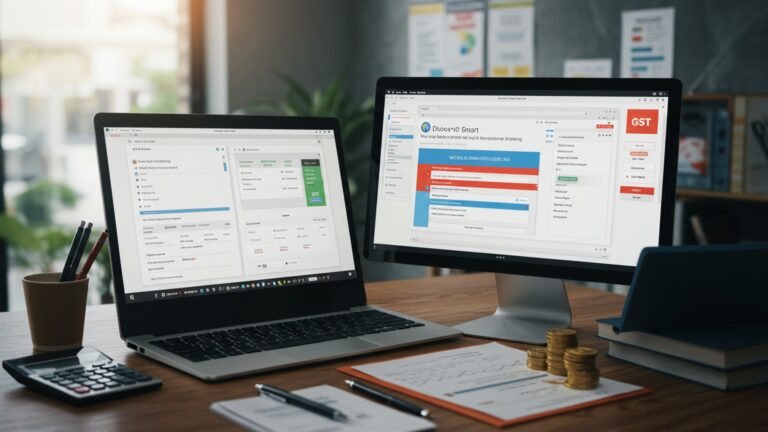7 Essential GST Invoicing Tips for Small Business Success
Navigating the complexities of Goods and Services Tax (GST) compliance often presents a significant hurdle for small businesses, where an overlooked detail on an invoice can trigger audits, penalties, or even block crucial input tax credits. Many entrepreneurs inadvertently make errors, from incorrect HSN/SAC codes to non-adherence with evolving e-invoicing mandates, particularly as turnover thresholds change. Beyond mere compliance, robust GST invoicing practices are vital for maintaining healthy cash flow and ensuring seamless reconciliation, which directly influences a business’s financial health in today’s digital economy. Mastering these essential GST invoicing tips transforms a potential administrative headache into a strategic advantage, safeguarding your operations and propelling growth.

1. Mastering the Mandatory Components of a GST Invoice
At the heart of successful GST compliance for any small business lies the perfectly crafted invoice. A GST invoice isn’t just a bill; it’s a legal document that validates a transaction and is crucial for claiming Input Tax Credit (ITC). Understanding its mandatory components is the first and most vital of all GST invoicing tips.
According to the Central Goods and Services Tax (CGST) Act, 2017. its rules, every tax invoice must contain specific details. Missing even one can lead to non-compliance, penalties. issues for your customers in claiming ITC. Here’s a breakdown of the essential elements:
- Invoice Number and Date
- Supplier’s Details
- Recipient’s Details
- HSN/SAC Codes
- Description of Goods/Services
- Value of Supply
- Tax Rates and Amounts
- Total Value of Supply
- Place of Supply
- Reverse Charge Mechanism (RCM) Declaration (if applicable)
- Signature/Digital Signature
A unique, sequential serial number (max 16 characters, alphanumeric) specific to a financial year, along with the date of issue. This ensures traceability.
Your business’s legal name, address. Goods and Services Tax Identification Number (GSTIN). Your GSTIN is a 15-digit unique identification number assigned to every registered taxpayer.
The legal name, address. GSTIN of your customer (if registered). If the customer is unregistered and the value of the supply is more than INR 50,000, their name and address (and the address of delivery) are still required.
Harmonized System of Nomenclature (HSN) for goods and Service Accounting Code (SAC) for services. These codes classify goods and services globally. Small businesses with an annual turnover of up to INR 5 crore generally need to mention a 4-digit HSN/SAC code, while those above INR 5 crore must use 6-digit codes.
A clear, concise description of what is being supplied, including quantity (for goods) or duration (for services).
The taxable value of the goods or services, excluding GST.
Clearly state the applicable CGST, SGST/UTGST, IGST. Cess rates, along with the corresponding tax amounts for each.
The total amount including GST, both in figures and words.
This determines whether CGST+SGST/UTGST or IGST is applicable. For instance, if the supplier and recipient are in the same state, it’s an intra-state supply (CGST+SGST). If they are in different states, it’s an inter-state supply (IGST).
If the recipient is liable to pay tax under RCM, a clear statement to that effect is necessary.
The invoice must be signed by an authorized signatory of your business.
Imagine a small stationery shop that also offers printing services. When they sell a batch of notebooks and provide design services, their invoice must list both the HSN code for notebooks and the SAC code for printing services, clearly segregating the taxable values and applicable GST. This meticulous detail prevents disputes and facilitates smooth ITC for their business clients.
2. Ensuring Accuracy and Compliance with HSN/SAC Codes and Tax Rates
Beyond merely including the mandatory fields, the accuracy of the insights presented on your GST invoice is paramount. Incorrect HSN/SAC codes or misapplied tax rates can lead to significant compliance issues, including fines, denial of ITC to your customers. complexities during audits. This makes accuracy one of the most critical GST invoicing tips.
These codes are not merely arbitrary numbers; they are the backbone of GST classification. The government uses these codes to determine the applicable tax rate for specific goods and services. For small businesses, especially, correctly identifying and applying the relevant HSN for goods or SAC for services is crucial. It’s not uncommon for businesses to mistakenly use a generic code when a more specific one exists, or vice versa, leading to discrepancies.
- How to ensure accuracy
- Refer to Official Sources
- interpret Your Products/Services
- Regular Review
Always consult the official CBIC (Central Board of Indirect Taxes and Customs) website or the GST portal for the latest HSN/SAC code lists and their corresponding tax rates. These are updated periodically.
Deeply grasp the nature of the goods you sell or services you provide to correctly map them to the appropriate HSN/SAC code. For example, ‘packaged food items’ might have a different HSN and tax rate than ‘fresh produce’.
Periodically review your product/service catalog against the HSN/SAC database, especially if you introduce new offerings or if there are changes in GST law.
GST rates are prescribed by the GST Council and vary widely (0%, 5%, 12%, 18%, 28% and sometimes Cess). Applying the wrong tax rate is a common pitfall. For instance, charging 18% GST on an item that falls under the 12% slab means you’ve overcharged your customer (and potentially collected excess tax that needs to be refunded or adjusted), while undercharging means you owe the government more tax than you declared.
Comparison: Manual vs. Software for HSN/SAC & Tax Rates
| Feature | Manual Invoicing | GST Compliant Software |
|---|---|---|
| HSN/SAC Code Application | Requires manual lookup and entry for each item, prone to human error. | Automated lookup and assignment based on product master data, reduces errors. |
| Tax Rate Calculation | Manual calculation, requires constant monitoring of rate changes, high error risk. | Automatic application of correct rates based on HSN/SAC and place of supply, updates rates automatically. |
| Compliance Updates | Business owner must manually track and implement all legislative changes. | Software providers update the system to reflect changes in GST laws and rates. |
| Time & Efficiency | Time-consuming, especially for businesses with diverse product lines. | Significantly faster, generates accurate invoices in seconds. |
| Audit Readiness | Difficult to prove accuracy; requires manual verification of each invoice. | Generates audit trails and ensures consistency, simplifying audits. |
Invest in a reliable accounting or invoicing software that automates HSN/SAC code mapping and tax rate application. This isn’t just a convenience; it’s a strategic move for compliance and efficiency.
3. Understanding the Timeliness of Invoice Issuance
One of the often-overlooked yet critical GST invoicing tips revolves around the timing of invoice issuance. The GST law specifies clear deadlines for when a tax invoice must be issued. failure to adhere to these can attract penalties and affect your compliance rating.
The due dates for issuing an invoice vary depending on whether you are supplying goods or services:
- For Supply of Goods
- Normal Supply
- Continuous Supply of Goods
- For Supply of Services
- The invoice must be issued within 30 days from the date of supply of the service.
- For specified service providers (e. g. , banks, financial institutions, NBFCs), this period is extended to 45 days.
- Continuous Supply of Services
The invoice must be issued on or before the date of removal of goods for supply to the recipient. If the goods are not physically removed (e. g. , in a “bill to-ship to” model), the invoice should be issued on or before the date of delivery or making them available to the recipient.
For supplies where goods are provided continuously, the invoice should be issued on or before the statement or payment is received.
The invoice must be issued on or before the due date of payment or receipt of payment, or completion of an event as per the contract.
Why is timeliness crucial?
- Input Tax Credit (ITC)
- Tax Liability
- Penalties
Your customer can only claim ITC based on a valid tax invoice. Delayed invoices can delay their ITC claims, potentially impacting their cash flow and your business relationship.
The date of invoice issuance often determines the tax period in which the liability arises. Delaying invoices can lead to discrepancies between your GSTR-1 (outward supplies) and GSTR-3B (summary return), attracting scrutiny.
The GST law prescribes penalties for not issuing a tax invoice or issuing an incorrect invoice within the stipulated time.
“BuildRight Construction,” a small firm providing architectural and interior design services, initially struggled with invoicing delays. They often issued invoices several weeks after project completion. This led to their clients facing delays in claiming ITC. BuildRight itself faced issues reconciling their GSTR-1 with GSTR-3B. By implementing a strict policy to issue invoices within 7 days of service completion. leveraging their invoicing software to send automated reminders, they significantly improved their compliance and client satisfaction. This proactive approach to GST invoicing tips proved invaluable.
4. Implementing Robust Record-Keeping and Archiving Strategies
Effective record-keeping is not just a good business practice; it’s a non-negotiable requirement under GST law. Every GST invoice, along with related documents like credit notes, debit notes, delivery challans. payment vouchers, must be meticulously maintained for a specified period. This is one of the foundational GST invoicing tips for long-term compliance and audit readiness.
Under Section 36 of the CGST Act, 2017. Rule 56 of the CGST Rules, all accounts and records must be retained for at least 72 months (6 years) from the due date of furnishing the annual return for the financial year to which such records pertain.
- Physical Records
- Digital Records
Traditionally, businesses maintained physical copies of all invoices in well-organized folders. While still acceptable, this method is prone to loss, damage. can be cumbersome for retrieval during audits.
The GST law permits the maintenance of electronic records. This is highly recommended for small businesses due to its efficiency and security benefits.
- Enhanced Accessibility
- Improved Security
- Reduced Storage Costs
- Streamlined Audits
- Environmental Friendliness
Quickly retrieve any invoice with a few clicks, regardless of the year.
Digital records can be backed up to cloud storage, protecting them from physical damage (fire, flood) or theft. Access can also be restricted to authorized personnel.
Eliminates the need for physical storage space and filing cabinets.
Auditors can easily access and verify records, making the audit process smoother and faster.
Reduces paper consumption.
- Use Cloud-Based Accounting Software
- Regular Backups
- Standardized Naming Conventions
Most modern GST-compliant invoicing software solutions offer integrated cloud storage for your invoices and records.
Even if using cloud software, maintain periodic local backups (e. g. , on an external hard drive) as an extra layer of security.
Implement a clear naming convention for digital files (e. g. ,
[Invoice Number]-[Customer Name]-[Date]
) to facilitate easy searching and retrieval.
Store invoices in non-editable PDF format to maintain their integrity.
“In the digital age, treating your GST invoices like precious digital assets, securely stored and easily retrievable, is not just about compliance; it’s about building a resilient and future-proof business operation,” says a leading tax consultant specializing in SME compliance.
5. Leveraging Technology: The Power of GST-Compliant Invoicing Software
For small businesses, managing GST invoicing manually can be a labyrinth of rules, calculations. deadlines. This is where technology steps in as a game-changer, making ‘leveraging technology’ one of the most impactful GST invoicing tips. GST-compliant invoicing software simplifies the entire process, minimizing errors and saving invaluable time.
What is GST-Compliant Invoicing Software?
These are specialized software solutions (desktop or cloud-based) designed to automate the creation of tax invoices, credit notes, debit notes. other GST-related documents. They are built to adhere to the latest GST regulations and often integrate with accounting and GST filing platforms.
- Automated Compliance
- Automatically includes all mandatory fields (GSTIN, HSN/SAC, place of supply).
- Calculates CGST, SGST/UTGST, IGST. Cess accurately based on pre-defined HSN/SAC codes and customer locations.
- Keeps track of serial numbers, ensuring no duplicates or skipped invoices.
- Error Reduction
- Time Savings
- Simplified GST Returns
- Improved Cash Flow
- Enhanced Record-Keeping
- Professional Appearance
Eliminates manual calculation errors, wrong HSN/SAC codes. incorrect tax rates, significantly reducing the risk of penalties.
Rapidly generates invoices, allowing businesses to focus on core operations rather than administrative tasks.
Many software solutions can directly integrate with the GST portal or generate reports (like GSTR-1 data) in formats that can be easily uploaded, streamlining return filing.
Professional, timely invoices lead to faster payments from customers.
Digitally stores all invoices, making them easily searchable, accessible. ready for audits. Offers secure cloud backups.
Creates professional-looking invoices that enhance your brand image.
“GreenThumb Nurseries,” a small plant nursery, initially used Excel spreadsheets for invoicing. This was time-consuming, prone to errors in HSN codes for different plant varieties. made GST filing a nightmare. After adopting a cloud-based GST invoicing software, they found that their invoicing time was cut by 70%, HSN code errors disappeared. GSTR-1 filing became a matter of a few clicks. The software also provided real-time sales reports, aiding in better business decisions.
- Ease of Use
- Scalability
- Integration
- Customer Support
- Cost
User-friendly interface is crucial for small business owners who might not be tech-savvy.
Can it grow with your business?
Does it integrate with other tools you use (e. g. , payment gateways, e-commerce platforms)?
Reliable support is essential for troubleshooting.
Compare features and pricing plans to find one that fits your budget.
6. Navigating Special Scenarios: Reverse Charge Mechanism, Exports. Nil-Rated Supplies
While standard GST invoicing covers most transactions, small businesses often encounter specific scenarios that require distinct invoicing approaches. Understanding these nuances is a crucial set of GST invoicing tips to ensure comprehensive compliance.
- Reverse Charge Mechanism (RCM)
- Definition
- Common Scenarios
- Supply of services by a goods transport agency (GTA) to specific recipients.
- Legal services by an individual advocate or firm to a business entity.
- Services supplied by an arbitral tribunal to a business entity.
- Purchases from unregistered suppliers by a registered person (though this specific provision has been largely suspended for most supplies).
- Supply of certain goods like raw cotton, cashew nuts (not shelled or peeled), etc.
- Invoicing Tip
- Example
- Exports and Zero-Rated Supplies
- Definition
- Invoicing Tip
- Example
- Nil-Rated, Exempt. Non-GST Supplies
- Definition
- Nil-Rated
- Exempt
- Non-GST
- Invoicing Tip
- Example
In most cases, the supplier collects GST from the recipient and remits it to the government. Under RCM, the liability to pay tax shifts from the supplier to the recipient of goods or services.
When you are the supplier in an RCM scenario, your tax invoice must clearly state that “Tax is payable by the recipient under Reverse Charge.” As the recipient liable to pay tax under RCM, you must issue a payment voucher and a self-invoice for the inward supply.
A small manufacturing unit (registered) hires an individual freelance graphic designer (unregistered) for logo design. The manufacturing unit is liable to pay GST under RCM for this service and must issue a self-invoice.
Exports of goods or services. supplies to Special Economic Zones (SEZ) units/developers, are treated as “zero-rated supplies” under GST. This means no GST is charged on these supplies. suppliers can claim ITC on inputs used for such supplies.
For exports, the invoice must clearly state “Supply meant for Export under Bond or LUT without payment of IGST” or “Supply meant for Export on payment of IGST,” depending on the route chosen. It should also mention the shipping bill number and date. For supplies to SEZ, it should state “Supply to SEZ Unit/Developer for authorised operations.”
A small handicraft exporter sends a consignment to the USA. Their invoice will show the value of goods but zero GST, along with the declaration that it’s an export without payment of IGST (if they’ve filed a Letter of Undertaking or Bond).
Goods/services on which GST is 0% (e. g. , certain essential food items).
Goods/services explicitly exempted from GST (e. g. , certain agricultural services, healthcare services by clinical establishments).
Items outside the purview of GST (e. g. , alcohol for human consumption, petrol, diesel, natural gas).
For these supplies, you issue a “Bill of Supply” instead of a “Tax Invoice.” A Bill of Supply doesn’t charge GST. you cannot claim ITC on inputs for such supplies. But, if a registered person makes both taxable and exempt/nil-rated supplies, they can issue a single invoice cum bill of supply, clearly distinguishing between the two types of supplies.
A local farmer selling fresh vegetables (nil-rated) alongside processed organic snacks (taxable) to a grocery store would issue a single invoice cum bill of supply.
Navigating these special scenarios requires attention to detail. Utilizing GST invoicing tips and a robust software can help configure these specific invoice types correctly, reducing the risk of non-compliance.
7. Embracing Regular Reconciliation and Error Correction
The final, yet continuously ongoing, of our essential GST invoicing tips is the practice of regular reconciliation and proactive error correction. Issuing perfect invoices is only half the battle; ensuring they align with your inward supplies and the government’s records is vital for a healthy ITC flow and avoiding future tax demands.
What is Reconciliation?
GST reconciliation involves matching the sales data reported in your GSTR-1 with your GSTR-3B. most importantly, matching the purchases (inward supplies) recorded in your books with the data available in GSTR-2A and GSTR-2B on the GST portal. GSTR-2A is a dynamic statement showing all inward supplies for a recipient based on the GSTR-1 filed by their suppliers. GSTR-2B is a static, auto-drafted ITC statement generated on the 14th of every month, providing ITC insights for a specific period.
Why is Reconciliation Crucial for Small Businesses?
- Maximizing ITC
- Avoiding Discrepancies
- Supplier Compliance
- Error Detection
Unreconciled invoices mean potential ITC that you might miss claiming, directly impacting your cash flow and profitability. If a supplier hasn’t uploaded your invoice in their GSTR-1, it won’t appear in your GSTR-2A/2B. you won’t be able to claim ITC on it.
Mismatches between your records and the GST portal can trigger notices from tax authorities, leading to audits and penalties.
Regular reconciliation helps you identify suppliers who are not filing their GSTR-1 returns correctly or on time, allowing you to follow up with them.
Helps in identifying errors in your own invoices or your supplier’s invoices (e. g. , incorrect GSTIN, wrong tax amount, typo in invoice number).
- Monthly Review
- Compare with Purchase Register
- Identify Mismatches
- Invoices in your books but not in GSTR-2A/2B (supplier hasn’t uploaded).
- Invoices in GSTR-2A/2B but not in your books (you might have missed recording them).
- Discrepancies in invoice value, GST amount, or GSTIN.
- Follow Up with Suppliers
- Rectify Your Records
- Utilize Software
Download your GSTR-2A and GSTR-2B statements monthly from the GST portal.
Match these statements with your internal purchase register or the purchase data from your accounting software.
Look for:
For missing invoices or discrepancies, proactively communicate with your suppliers to get them to rectify their GSTR-1.
If the error is on your end (e. g. , wrong GSTIN entered for a supplier), correct your internal records.
Many GST-compliant software solutions offer reconciliation features that automate much of this process, highlighting mismatches for your review.
A small IT consultancy firm notices that an invoice for software purchase, which they have in their books, is not appearing in their GSTR-2B. Upon contacting the supplier, they discover the supplier accidentally entered a wrong GSTIN while filing their GSTR-1. The supplier then files an amendment to their GSTR-1. the invoice appears in the consultancy’s GSTR-2B, allowing them to claim the rightful ITC. Without regular reconciliation, this ITC would have been lost.
By making regular reconciliation a non-negotiable part of your monthly GST routine, you ensure compliance, optimize ITC. maintain healthy financial records, making these GST invoicing tips a cornerstone of your business success.
Conclusion
Mastering GST invoicing isn’t merely about compliance; it’s a strategic pillar for your small business’s financial health and credibility. By diligently implementing these tips – from ensuring accurate HSN/SAC codes to embracing digital solutions for timely generation – you’re not just avoiding penalties, you’re building a robust financial backbone. I’ve personally seen how a seemingly minor error, like an incorrect GSTIN, can snowball into administrative headaches and delayed payments. The current trend towards mandatory e-invoicing for a wider range of businesses further underscores the necessity of proactive, precise invoicing practices. Therefore, treat your invoices as more than just bills; they are reflections of your professionalism and critical tools for efficient cash flow and simplified reconciliations. Take action today to streamline this process, ensuring every transaction contributes to your success, not just your ledger.
More Articles
7 Essential Strategies to Streamline Your Billing Process for Maximum Efficiency
7 Proven Ways to Streamline Your Billing Process and Boost Cash Flow
How to Select the Best Billing and POS Software for Your Business
How to Select the Best POS Software Guide for Business Efficiency
How to Optimize Inventory Management POS India for Profit Growth
FAQs
What absolutely must be on my GST invoices to be compliant?
Your GST invoices need a few key things: your GSTIN, a unique sequential invoice number, the date, full details of both you (the seller) and the buyer, HSN/SAC codes for what you’re selling, the applicable tax rates. the total amount including tax. Missing any of these can lead to compliance headaches!
How should I number my GST invoices? Is there a special way?
Yes, there absolutely is! Your invoice numbers must be unique for each financial year and follow a continuous, sequential pattern. This system is crucial for accurate tracking, simplified record-keeping. smooth compliance during any audits. Don’t skip numbers or reuse them!
What are HSN/SAC codes. why are they essential for my invoices?
HSN (Harmonized System of Nomenclature) codes are for goods. SAC (Services Accounting Code) codes are for services. They’re standardized codes that classify what you’re selling. Including the correct codes on your invoices is vital for accurate tax calculation and reporting, helping you avoid errors and potential penalties.
Do I need to show all the different GST components separately on my invoice?
Absolutely! It’s mandatory to clearly show the breakdown of GST components like CGST (Central GST), SGST (State GST), or IGST (Integrated GST), along with any applicable cess. This transparency helps your buyers interpret the tax they’re paying and is essential for them to claim their Input Tax Credit (ITC).
Is there a deadline for issuing GST invoices?
Yes, there are specific timelines you need to stick to. Generally, for goods, an invoice should be issued before or at the time of removal or delivery. For services, it’s typically within 30 days from the date of providing the service (or 45 days for banks/NBFCs). Missing these deadlines can lead to non-compliance.
After I issue an invoice, do I need to keep a copy? For how long?
Definitely! You must maintain proper records of all your GST invoices, whether they’re digital or physical. The general rule is to keep them for at least 72 months (six years) from the due date of filing the annual return for the relevant financial year. This is crucial for any potential audits or scrutiny.
Besides a regular tax invoice, are there other types I might need to issue?
Yes, depending on your transactions. For instance, if you’re supplying exempted goods/services or selling to an unregistered person, you’d issue a ‘Bill of Supply.’ You also have ‘Debit Notes’ (for increasing the value of supply) and ‘Credit Notes’ (for reducing it, or for sales returns). Knowing when to use each is a key part of smart GST invoicing.






